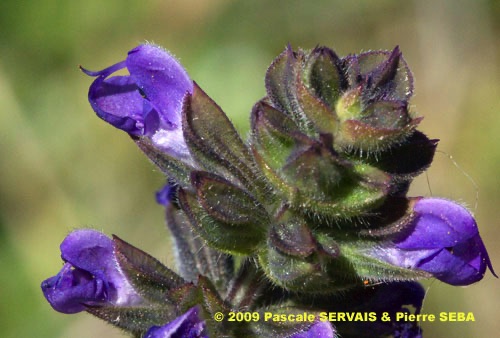
Salvia verbenaca L.
Fam. : Lamiaceae
© Pascale SERVAIS & Pierre SEBA, 2018. Tilo Botanica: Flore de Tilos et du Dodécanèse / Flora of Tilos and of the Dodecanese
English translation by Brenda Bradbury, Howard Bradbury and Stéphane Léonard
Plante herbacée, hermaphrodite, à tiges dressées, simples ou ramifiées, à poils glanduleux.
Feuilles à la base ou opposées, gaufrées dessus, dentées, simples, ovales ou divisées pennatifides, à lobes oblongs. Feuilles de la base à long pétiole, les supérieures sessiles.
Fleurs à symétrie bilatérale, bleu pâle, lilas ou violettes, de 6 à 10 mm de long, réunies en verticilles étagés, lâches à assez denses. Corolle à 2 lèvres, parfois non épanouie. Calice à 5 sépales soudés, velus. Ovaire supère.
Fruits, 4 akènes bruns ou noirâtres.
___________________________
Plant herbaceous, hermaphrodite. Stems erect, simple or branched, with glandulous hairs.
Leaves at the base or opposite, embossed above, toothed, simple, ovate or dissected pinnatifid, with oblong lobes. Basal leaves with a long petiole, the higher ones sessile.
Flowers bilaterally symmetrical, pale blue, lilac or violet, from 6 to 10 mm long, joined together in tiered, loose to rather dense whorls. Corolla two-lipped, sometimes not opened out. Calyx with 5 fused, very hairy sepals. Ovary superior.
Fruits, 4 brown or blackish achenes.
Descripteurs / Identifying features
1
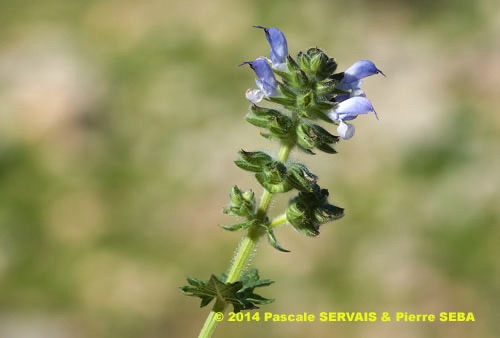
2
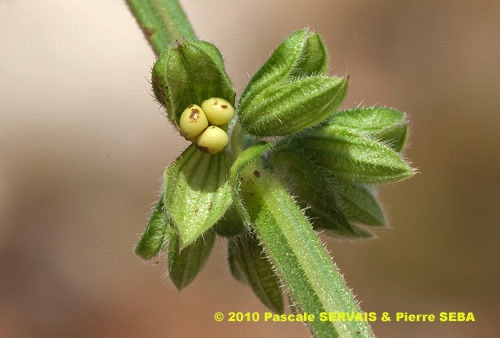
3
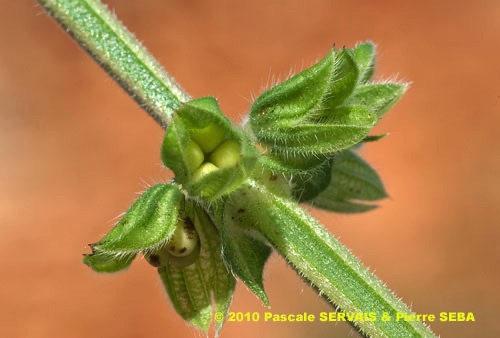
4
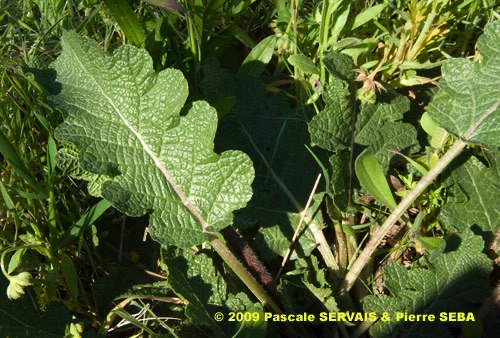
5
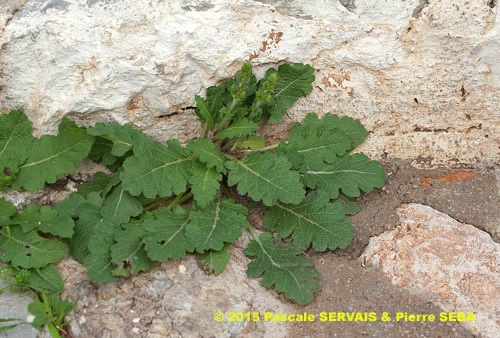
6
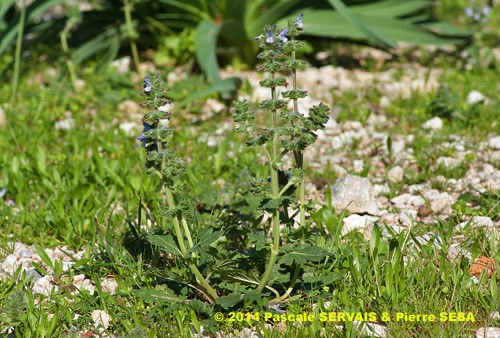
7
Étymologie / Etymology :
Salvia : emprunt du latin salvia, -ae (nom) [ < salvo, -as, -are (verbe)
= guérir, sauver ] = la sauge, nom donné à la plante par Pline,
naturaliste latin mort en 79 apr. J.-C., en référence à ses propriétés
médicinales.
Verbenaca : emprunt du latin verbenaca, -ae (nom) = la verveine, nom
donné à la plante par Pline, naturaliste latin mort en 79 apr. J.-C.,
en référence à la ressemblance de ses feuilles avec celles de la
verveine.
Salvia : borrowed from Latin salvia, -ae (noun) [ < salvo, -as, -are (verb)
= to heal, to save ] = sage, name given to the plant by Plinius, Latin
naturalist died in 79 AD, referring to its medicinal properties.
Verbenaca : borrowed from Latin verbenaca, -ae (noun) = verbena, name
given to the plant by Plinius, Latin naturalist died in 79 AD, referring to
the resemblance of its leaves to those of the verbena.
Synonymes / Synonyms :
Flipanta ovata Raf.
Gallitrichum stereocaulon Jord. & Fourr.
Gallitrichum verbenaca (L.) Fourr.
Gallitrichum virgatum Jord. & Fourr.
Horminum verbenaca (L.) Mill.
Salvia barnolae Sennen
Salvia betonicifolia Lam.
Salvia controversa Ten.
Salvia domenechii Sennen
Salvia hiemalis Brot.
Salvia horminoides Pourr.
Salvia laciniata Willd. ex Schltr.
Salvia lanigera Poir.
Salvia linnaei Rouy
Salvia linnaei subsp. multifida (Sm.) Rouy
Salvia linnaei subsp. oblongata (Vahl) Rouy
Salvia littoralis Ferrary
Salvia mixta Timb.-Lagr.
Salvia multifida Sm.
Salvia neglecta Ten.
Salvia oblongata Vahl
Salvia ochroleuca Coss.
Salvia pallidiflora St.-Amans
Salvia polymorpha Hoffmanns. & Link
Salvia rhodantha Zefir.
Salvia verbenaca subsp. controversa Batt.
Salvia verbenacoides Brot.
Salvia verbenifolia Salisb.
Sclarea decidua Moench
Sclarea verbenaca (L.) Soják
Noms vernaculaires / Common names :
Noms français / French names :
Sauge à feuilles de verveine — Sauge clandestine —
Sauge fausse verveine.
Noms grecs / Greek names :
Αγριοβασιλικός — Άγριος βασιλικός — Βουτυρόχορτο —
Γοργογιάννης — Σάλβια η βερμπενοειδής — Φασκομηλιά.
Noms anglais / English names :
Vervain sage — Wild clary.
Noms allemands / German names :
Eisenkraut-Salbei — Eisenkrautsalbei.
Noms espagnols / Spanish names :
Cresta de galla — Gallocresta — Hierba de ciego —
Hierba de Santa Lucía.
Nom italien / Italian name :
Salvia minore.
Habitat :
Lieux pierreux - Lieux incultes - Chemins.
Stony places - Waste ground - Waysides.
Île / Island :
Tilos.
Hauteur / Height range :
De 10 cm à 70 cm.
From 10 cm to 70 cm.
Floraison / Flowering time :
De janvier à septembre.
From January to September.
Groupe / Classification :
Dicotylédones.
Dicotyledons.
Pérennité / Lifespan :
Vivace.
Perennial.
Description :
Clés dichotomiques et descripteurs distinctifs des 3 espèces / Dichotomous keys and distinctive identifying features of the 3 species
Photo 1 :
Localisation / Location : Tilos, Livadia, Village
Date : 16/03/2009
GPS : Lat. 36,41294° N / Long. 27,38585° E / Alt. 7 m
Type : Photographie numérique / Digital Photograph (10 mégapixels)
Photo 2 :
Localisation / Location : Tilos, Megalochorio, Panaghia Kamariani
Date : 11/02/2014
GPS : Lat. 36,45717° N / Long. 27,32152° E / Alt. 46 m
Type : Photographie numérique / Digital Photograph (10 mégapixels)
Photo 3 :
Localisation / Location : Tilos, Megalochorio, Panaghia Kamariani
Date : 28/11/2010
GPS : Lat. 36,45717° N / Long. 27,32152° E / Alt. 46 m
Type : Photographie numérique / Digital Photograph (10 mégapixels)
Photo 4 :
Localisation / Location : Tilos, Megalochorio, Panaghia Kamariani
Date : 28/11/2010
GPS : Lat. 36,45717° N / Long. 27,32152° E / Alt. 46 m
Type : Photographie numérique / Digital Photograph (10 mégapixels)
Photo 5 :
Localisation / Location : Tilos, Livadia, Village
Date : 16/03/2009
GPS : Lat. 36,41294° N / Long. 27,38585° E / Alt. 7 m
Type : Photographie numérique / Digital Photograph (10 mégapixels)
Photo 6 :
Localisation / Location : Tilos, Livadia, Village
Date : 26/11/2010
GPS : Lat. 36,41649° N / Long. 27,38474° E / Alt. 12 m
Type : Photographie numérique / Digital Photograph (10 mégapixels)
Photo 7 :
Localisation / Location : Tilos, Megalochorio, Panaghia Kamariani
Date : 11/02/2014
GPS : Lat. 36,45717° N / Long. 27,32152° E / Alt. 46 m
Type : Photographie numérique / Digital Photograph (10 mégapixels)

Google Maps
Google Maps
Google Maps
Google Maps
Google Maps
Google Maps
Google Maps